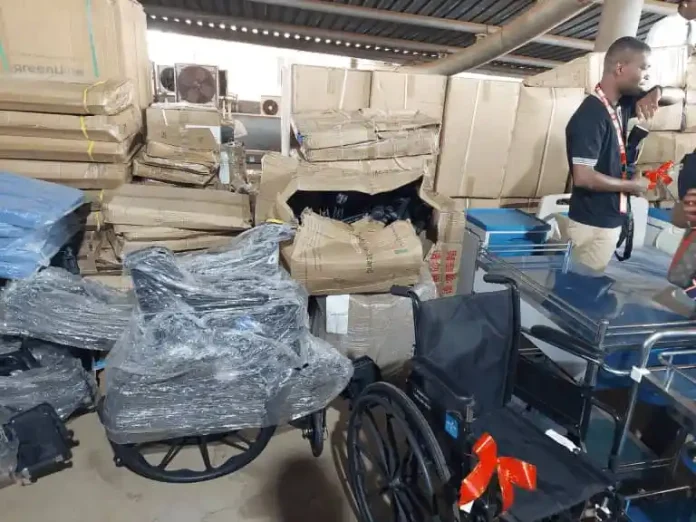
The Komfo Anokye Teaching Hospital received critical support Friday when the Church of Jesus Christ of Latter-day Saints donated medical equipment valued at $100,000, a gesture responding to the Asantehene’s “Heal Komfo Anokye” initiative aimed at revitalising one of Ghana’s most important referral centres.
The donation arrives at a moment of acute urgency. KATH, a 1,200-bed facility receiving referrals from across Ghana’s northern regions, operates under severe equipment constraints that threaten diagnostic and patient care capacity. The hospital’s only available MRI machine functions at fault, while CT Scans remain non-operational despite management’s strenuous efforts, forcing the facility to turn away patients requiring critical imaging diagnostics.
Chief Executive Officer Dr. Paa Kwesi Baidoo acknowledged the crushing weight of these limitations. “There’s one MRI machine that is working at fault and it’s so expensive getting these items. CT Scans are not working. We’re trying to bring these to life,” he said at the donation ceremony. The CEO has previously disclosed that essential vital equipment including fluoroscopy units, oxygen plants, and central sterilisation systems are either malfunctioning or completely down, while critical facilities such as a Catheterisation Laboratory and Mammogram unit remain entirely absent.
The church’s consignment addresses immediate operational gaps without tackling KATH’s most expensive problems. The donation includes 40 cardiac tables, 15 electronic beds, 20 patient monitors, 15 hydraulic patient stretchers, dual ABS medicine trolleys, 30 folding bed screens, 30 wheelchairs, 15 crash trolleys, and 40 drip stands. These items will improve hospital capacity and patient comfort, yet they bypass the diagnostic equipment crises that most acutely constrain service delivery.
The gift forms part of the broader “Heal Komfo Anokye” project spearheaded by Otumfuo Osei Tutu II, the Asantehene. The initiative aims to address urgent infrastructural improvement at Ghana’s second-largest teaching hospital, which receives referrals from 12 out of Ghana’s 16 regions. The royal initiative reflects the hospital’s regional and national significance as a referral hub serving millions.
Yet funding constraints threaten the project’s scope. Baidoo disclosed that the required investment has escalated due to inflation and unstable economic conditions, requiring additional resources beyond initial planning. The Asantehene’s 25th Anniversary Legacy Projects represent a transformative initiative aimed at creating lasting impact in the Ashanti region and beyond, but delivering that transformation requires sustained commitment from multiple stakeholders.
Elder Isaac Morrison, the Second Counsellor in the Africa Area Presidency of the Church of Jesus Christ of Latter-day Saints, framed the donation within a theological framework of human dignity. “These items are not merely tools. They’re instruments of healing, symbols of our solidarity and God’s expression of love for His children,” he said. The church emphasised its commitment to supporting humanitarian causes across the world without regard to geography or economic status.
KATH has earned recognition for operational excellence despite resource constraints. Parliament’s Select Committee on Health recently praised KATH for its cleanliness, administrative efficiency, and strategic use of internally generated funds for infrastructure, urging other state-owned facilities to emulate its management standards. This commendation underscores that the hospital’s challenges stem from systemic underfunding rather than mismanagement.
Yet operational excellence cannot overcome equipment deficits. Despite recording notable performance gains in the first half of 2025 including a 5 per cent increase in specialist OPD attendance above target and 7 per cent increase in surgeries above target, the hospital faces steep declines in laboratory services, deliveries, and primary care—underscoring how equipment shortages constrain capability across departments.
The donation demonstrates that private philanthropic engagement can supplement government health funding. Yet Baidoo’s continued appeals for assistance suggest that single donations, however generous, cannot address KATH’s structural funding deficits. The Ghana Medical Trust Fund has begun a nationwide initiative to provide essential medical equipment to hospitals, with administrators emphasising that “there is an urgent need to replace outdated machines and ensure hospitals are equipped to serve the people”.
For patients and families accessing KATH’s services, the church’s gift provides tangible immediate benefits through improved hospital capacity and comfort. Yet the diagnostic equipment crisis persists. Regional health authorities argue that donations advance progress toward Universal Health Coverage by 2030, but achieving that objective will require far more sustained investment in diagnostic capacity than current philanthropic channels provide.
The “Heal Komfo Anokye” project continues advancing incrementally through gifts like the church’s donation and government efforts. Yet the pace of improvement may not match the scale of need facing Ghana’s primary teaching hospital.
